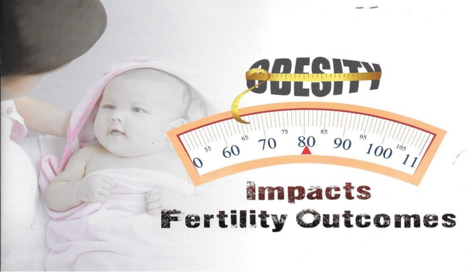What is the relationship between body weight and infertility? Sex steroid hormones—testosterone (the principal male hormone) and estradiol (the principal female hormone)—are lipid soluble, i.e.; they dissolve in fat but not in water. Thus, these hormones accumulate in body fat. Once body fat stores are saturated with sex steroid hormones, they reach equilibrium with blood. In addition to the stored source of sex steroid hormones in body fat, the gonads secrete testosterone and estradiol to maintain the levels necessary to sustain reproductive function. In addition to the storage capacity of body fat for sex steroid hormones, adipose cells (fat cells) convert the weak male hormone, androstenedione, to the weak female hormone, estrone. Estrone, though not as potent as estradiol, has metabolic effects on the hypothalamic-pituitary axis of the brain (the area of the brain that regulates testicular and ovarian function) to alter reproductive function. These complex interactions have the net effect of impairing reproductive function. These effects of body weight on female reproductive function are well established.
However, the effects of body weight on male reproductive function are not well studied and are more speculative. There are differential metabolic pathways for estradiol metabolism in women depending on body weight. Slender women metabolize estradiol to 2-hydroxyestrone—an antiestrogen; obese women metabolize estradiol to estriol—a weak estrogen. The rate of metabolic change seems to correlate with the percent of body fat of total body mass. Thus, slender women progressively “turn down” the reproductive cycle until it is “turned off” when the condition of anorexia nervosa (defined as less than 85% of predicted ideal body weight for height) is reached. On the other hand, obese women progressively increase their alternate estrogens—estrone and estriol— until ovulation ceases and they become infertile. It is ironic that both thin and obese women develop irregular reproductive cycles, but by entirely different mechanisms. Thin women are estrogen deficient whereas obese women have an excess of estrogen but do not cycle on a regular basis. It is well established that body fat affects the onset of puberty in girls. Most of us have observed early breast development in “chubby girls” and delayed breast development in thin girls. Girls who participate in strenuous training programs such as gymnastics or ballet have delayed puberty. Their secondary sexual development (breasts, pubic hair, menstruation, ovulation) does
not occur until they reduce or stop their training program and increase their body fat. There are reports of earlier puberty in girls during the past decade. This may reflect the relationship between body fat, a fast-food diet, and secondary sexual development. If we relate the earlier onset of puberty to the early accumulation of body fat, it is likely that sufficient estradiol is being sequestered in body fat to initiate secondary sexual development. With progressive accumulation of body fat that approaches obesity (as defined as greater than 120% of predicted ideal body weight for height) in adolescent girls, reproductive function may begin as a normal physiologic event and progress to impairment of reproductive function within a few years. Not only should adults be aware of this relationship between body weight and reproductive function, but parents should be aware of the relationship as well. Parents can counsel their adolescent children about the impact of body fat on the secondary sexual development and reproductive function of their adolescent children. Despite the number of publications, both scientific publications and lay publications in the media, there is lack of knowledge about the relationship between body weight and infertility. This paper is an effort to further educate about this relationship so those couples contemplating pregnancy can assess their body weight as it pertains to their potential to conceive a pregnancy. This is an opportunity for infertile couples to understand the impact of body weight on their reproductive capacity and take steps, without expert advice, to improve their reproductive capacity.

